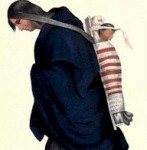
The life of the Indian woman, under the most favorable circumstances, is one of continual labor and unmitigated hardship. Trained to servitude from infancy, and condemned to the performance of the most menial offices, they are the servants rather than the companions of man. Upon them, therefore, fall, with peculiar severity, all those vicissitudes and accidents of savage life which impose hardships and privations beyond those that ordinarily attend the state of barbarism. Such is the case with the tribes who inhabit a sterile region, or an inhospitable climate, where the scarcity of food, and the rigor of the seasons enhance the difficulty of supporting life, and impose the’ most distressing burdens on the weaker sex. The Chippeway, or, as they pronounce their own name, the Ojibway nation, is scattered along the bleak shores of our north-western lakes, over a region of barren plains, or dreary swamps, which, during the greater part of the year, are covered with snow and ice, and are, at all times, desolate and uninviting. Here the wretched Indian gleans a precarious subsistence; at one season by gathering the wild rice in the rivers and swamps, at another by fishing, and a third by hunting. Long intervals, however, occur when these resources fail, and, when exposed to absolute and hopeless want, the courage of the warrior and the ingenuity of the hunter sink into despair. The woman who, during the season of plenty, was worn down with the labor of following the hunter to the chase, carrying the game and dressing the food, now becomes the purveyor of the family, roaming the forest in search of berries, burrowing in the earth for roots, or ensnaring the lesser animals. While engaged in these various duties, she discharges, also, those of the mother, and travels over the icy plains with her infant on her back.
